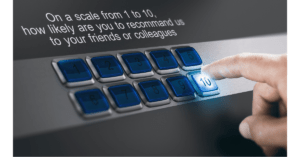Rating scale questions are commonly used in surveys to assess customer satisfaction and preferences. They provide a way for respondents to indicate their level of agreement, preference, or satisfaction with a given statement or question. In this blog, we will explore the various types of rating scales that you can use in your surveys.
What are Rating Scale Questions?
Rating Scale Questions are a type of survey question that asks respondents to rate their satisfaction or preference on a scale, which can be numerical or descriptive. They are widely used in surveys, market research, and customer feedback forms to collect quantitative data that can be analyzed and compared across different groups.
Linear Numeric Scale
Linear numeric scale questions are an essential part of any online survey. Respondents rate their satisfaction or preference using numbers on a scale ranging from 0-10. This type of rating scale provides quick insights into customer preferences and is easy to understand. However, this type of question should be used in conjunction with other types of survey questions as it may not capture more nuanced or complex feedback accurately.
Graphic Scales: Examples
Graphic rating scales are an easy-to-understand feedback methodology and use visual cues for responses. A classic example is the Likert scale which provides participants with various statements and asks them to rate their level of agreement/disagreement. Another type is the semantic differential scale where abstract concepts such as ‘good’ vs ‘bad’ can be rated using a series of bipolar adjectives. A third type is the visual analogue scale which uses a continuous line or bar for respondents to mark their level of intensity.

Visual Analog / Slider Scale
Engage your participants thoroughly with the visually engaging and user-friendly visual analog/slider scale. It’s an alternative to traditional numerical rating scales that empowers respondents to slide along a line marking their response in real-time. The flexibility of this type of question allows it to be tailored to the needs of any target audience and situation. Use this tool alongside likert scales or matrix questions for enhanced quantitative data analysis.
Likert Scale
The Likert Scale is a popular choice for conducting surveys and research. It can measure participants’ strength of preference or level of agreement with abstract concepts using response options ranging from 1-5 or 1-7. With its ease of use and ability to provide quantitative data, this type of rating scale question has become a go-to option for online survey creators across various sectors such as customer service, customer experience (CES), customer satisfaction and more. However, it is essential to keep in mind that the likert scale should have an equal number of positive and negative statements to provide accurate results.
Multiple Rating Matrix
Multiple rating matrix is another common choice among researchers. With this method, respondents are presented with a set of questions that have their own rating scale. The answers are then combined to get an overall score or ranking.
Survey Templates with Rating Scale Questions
Survey templates that include well-crafted rating scale questions are an excellent tool for gathering quantitative data on participants’ preferences, opinions and satisfaction. By utilizing a range of response options and ranking methods, you can get valuable insights from the resulting quantitative data. Analyzing the data collected in this manner can reveal trends and patterns that might not have been otherwise apparent.

Net Promoter Score (NPS) Survey
The Net Promoter Score survey assesses customer loyalty by measuring the likelihood of customers recommending a product or service. It has a single choice question and answer options ranging from 0-10. Respondents who score 9-10 are considered promoters, while those scoring 0-6 are detractors. The NPS score is calculated by subtracting the percentage of detractors from that of promoters, providing quantitative data for assessing customer satisfaction.
Training Evaluation Form
To effectively create a training evaluation form, use a well-designed rating scale that allows for quantitative data collection from participants. The form should include questions related to the quality and relevance of the training materials, effectiveness of the trainer, and overall satisfaction with the program. Training evaluation form is also a great way to gauge employee satisfaction mostly after a course program. It can also be distributed in universities to capture specific course related satisfaction metrics.
Frequency Scales
When conducting surveys, it’s crucial to use frequency scales to measure customer satisfaction accurately. Unlike other types of rating scales, frequency scales measure how often a respondent engages in a particular behavior or feels a certain way. To ensure that your survey questions are clear and concise, use simple language and limit the number of response options. Doing so will help you gather accurate quantitative data and make data-driven decisions to improve your product or service.
Choose Important Rating Scale Questions
When selecting a rating scale question, consider the research goals and the order of answer options as this can influence responses. Additionally, consider the mediums for survey distribution as well. To gain further insights, adding an open-ended question is recommended. Open ended questions are necessary as it is an option for people to share vivid responses that cannot be fully captured by closed ended rating scales.
Paired Comparison Scale
The Paired Comparison Scale is an essential rating system that compares two items at a time and evaluates customer preferences with products or services effectively. To get accurate results, it is crucial to use a large enough sample size. Understanding how to employ the Paired Comparison Scale in your online survey question templates can significantly impact the ease of use for participants and the strength of preference they have between polar opposites.
Comparative Scale/Comparative Intensity
Comparative Scale/Comparative Intensity questions enable respondents to compare two or more items on a given attribute. These types of questions measure preferences across multiple options while providing valuable insights into consumer behavior. For instance, when conducting an online survey using Net Promoter Score (NPS), Comparative Scale/Comparative Intensity questions could be used to gather feedback on the quality of customer service across different channels (such as email or social media). By providing response options like matrix or choice question format with rating scales under these surveys can help gauge customer satisfaction levels while minimizing discomfort among participants.
Semantic Differential Scale
The Semantic Differential Scale enables researchers to gauge the attitudes and opinions of participants. Respondents must rate a series of bipolar adjectives or phrases separated by a neutral point on a customizable scale. This method of feedback also collects valuable insights into consumer preferences, satisfaction levels, and opinions regarding products or services. Additionally, this type of question belongs to the family of rating scales making it an excellent choice for gathering quantitative data.
Adjective Checklist
Adjective checklist questions allow participants to choose from pre-defined adjectives that best describe their experience or opinion. This type of question is commonly found in customer satisfaction surveys and product evaluations due. This method has the ability to provide reliable data by reducing response bias. Incorporating adjective checklist questions within a survey can provide quantitative data on participants’ preferences towards abstract concepts.
Semantic Distance Scale
Semantic Distance Scale is a scale ranging from 1 to 5. It measures the level of agreement or disagreement with a statement, making it perfect for use in online surveys or questionnaires. The Semantic Distance Scale is the perfect survey question type for assessing the strength of preference for different options without bias.
Customer Satisfaction Survey
Customer satisfaction survey is a scale that comprehends the level of satisfaction a customer will have with an experience, product or a service. It can be mapped from ‘very unsatisfied’ to ‘highly satisfied‘. Customer satisfaction or the CSAT metrics are very commonly used for in-app surveys or after an interaction with a customer service. The customer satisfaction metric is a good indicator of how satisfied or unhappy the consumer might be with a certain product or interaction.
Getting More Out of Rating Scale Questions
While creating or choosing the appropriate rating scale, there has to be a specific goal attached to the survey. Rating scales come in variety but using them at certain points will depend on what the marketer is willing to achieve. This method of seeking feedback will always have a context attached to it. However, to get more outcomes from your rating scale survey, it is recommended that you use an open-ended question at the end of the scale. This allows people to share candid feedback after they have shared quantitative insights.
Advantages
The use of rating scales in surveys offers a number of advantages. Firstly, it provides quantitative data which is easy to analyze and interpret. Secondly, it allows for comparison between different options or experiences. Thirdly, it enables the researcher to capture the strength of preference towards a particular option. All of these collectively make rating scale questions an essential tool for businesses looking to collect customer feedback and improve their services or products. This quantitative method of getting insight is very robust and widely used to collect serious data for internal processes and business protocols. Metrics such as net promoter score, customer satisfaction score (CSAT) and customer effort score (CES) methods are widely used, because a lot of this feedback collection protocol is the industry standard way of measuring customer satisfaction.
Disadvantages
Rating scales are highly precise that need a very specific answer. It purely collects data with numericals, ratings, emoticons etc. This can get constrictive when there is no option to seek open ended feedback. Adding a qualitative factor in such surveys can help collect more insightful customer feedback.
Another thing to point out is that it can get really confusing when questions are not clear or when the scales are not demarcated as they intend to be. Curating a detailed rating scale takes patience and precision. It is also a goal based method of taking a survey. If you think about it- where would you need a rating based method of collecting customer feedback. Even if you do, will it suit the nature of product and service per say.
How to Analyze Rating Scale Questions?
Merren provides a vivid dashboard that can analyze every collected data. This also includes open ended data that is segregated as per word cloud. The ratings can determine a detractor from a promoter. The analysis is also real time in nature under “trends and patterns.”
The dashboard allows clients to view and download data for their campaigns. every raw data will still be visible long after the campaigns are over. You can compare one data with relation to the other.
Example; using filters, you can map out the demographic data, the score data and view it across weekly , daily or monthly timelines. The segregations make it easier to pinpoint customers that might need immediate assistance or capture positive reviews.
Conclusion
Rating scale questions are a great way to assess customer satisfaction and preferences. From linear numeric to semantic differential scales, there are many options to choose from depending on your survey needs. With the right template and understanding of how to analyze data, using this metric of seeking feedback can provide valuable insights into customer satisfaction, training effectiveness, and workshop feedback.
To learn how Merren can supercharge your customer satisfaction protocols, sign up for our 14 day free trial here.

